The Beginning
The Wisconsin Union Theater, a premier venue with superb acoustics, performance space and seating, has a long and interesting history.
The idea of a theater wing came about in the pre-1920's by University President Van Hise and members of the Memorial Union Building Committee. They imagined a theater as an integral part of the Memorial Union, drawing the arts into the daily life of the campus.
It was the vision of one man, Porter Butts, that made it possible. With his organizational and fund-raising abilities, he made the Union Theater come to life.
The Opening
The opening of the Wisconsin Union Theater in 1939 marked the solution to a long-felt need for a theater at the University of Wisconsin-Madison. A statewide radio broadcast informed citizens of the October 8th inaugural ceremonies, and the next three days saw performances of Shakespeare's The Taming of the Shrew, starring the leading couple of the American Theatre, Alfred Lunt and Lynne Fontanne.
Countless artists over the years have echoed Alfred Lunt's opening night comment that "the acoustics are simply marvelous." The complementary art galleries host changing exhibits, contributing to the entire experience. For more than 60 years the Wisconsin Union Theater has been a cultural center for the entire state.
"The whole panorama of a nation at war and peace had been reviewed there," wrote the Madison Capital Times ten years after the theater's opening, and in the years since the theater has continued to reflect a vibrant kaleidoscope of arts, politics, public discussions and much more.
The Entertainment
Union Theater audiences since 1939 have seen and heard some of the most famous actors, dancers and musicians of the century; popular artists have entertained; renowned leaders have spoken; philosophers and scientists have challenged the mind. Fritz Kreisler, Ella Fitzgerald, Indian Prime Minister Nehru, Frank Lloyd Wright, Eleanor Roosevelt, Martin Luther King, Jr., Robert Frost, Itzhak Perlman, John F. Kennedy, Yo-Yo Ma, T.S. Eliot, Jesse Jackson, Arthur Rubinstein, Jascha Heifetz, Louis Armstrong, Martha Graham, Dave Brubeck.
Over the years, eminent personalities have communicated from this stage with over ten million people, and their influence has rippled throughout the world. The Union Theater has constantly won their praise for its facilities and its acoustics, but mostly for its audiences, who in turn continue to be the life force of the theater.
The People
Smoothness of operation and quality of programming, key elements in the theater's success over the years, have rested in the capable hands of many fine administrators, publicists and technicians, including Fan Taylor, Fred Buerki, Bill Dawson, Ralph Sandler and Michael Goldberg, to name just a few. Equally important have been the generations of students who today, as in the past, enjoy the opportunity to work with Union Theater staff in a variety of positions throughout production while learning leadership and management skills as well as enjoying the opportunity to meet world-famous personalities.
The Future
In the 21st Century, the Union Theater continues to flourish with ideas, programs, energy, and vision. That vision becomes a reality hundreds of times each year, when its doors open to a lively and inquiring audience. Over and over the mission of the theater is validated by applause as an artist is acknowledged, or by a significant silence as an important idea or a profound experience is considered. The Union Theater remains warm, lively and inviting, while the magic of great performances and the ferment of ideas continue to fill it.

